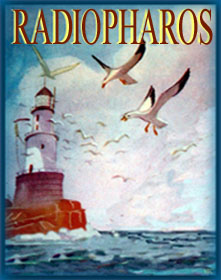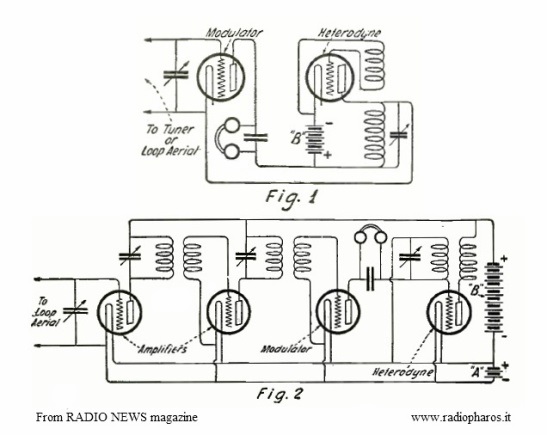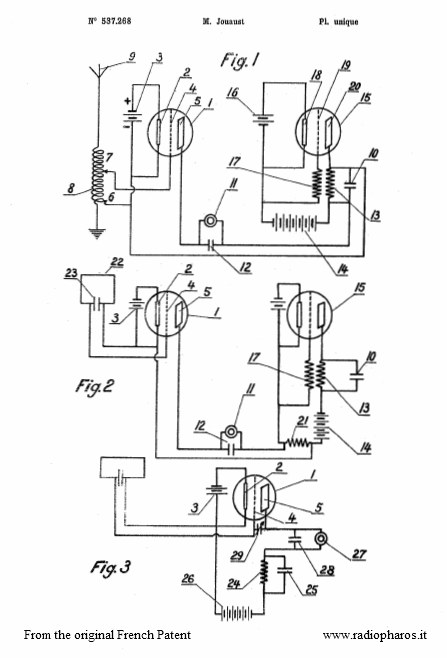|
Modulation System

I think
that the evolution of the "Modulation System" is not well known,
I hope to provide some more information with this article
THE MODULATION SYSTEM AND THE ULTRADYNE

R.E. Lacault returned to New York, accompanied by his wife
Alice, on 11th August 1923. The ship, named Paris, took almost a
week to cross the Atlantic Ocean from the port of Le Havre, in
France, to get to the one in New York. At that time Lacault was
still an associate editor of Radio News magazine. He left that
appointment almost two years later, in May 1925, after more than
four years with that magazine, to begin a new adventure as a
manufacturer of radio sets. His first article appeared in
December 1920 of Radio News (he became associate editor in
January 1921), it is in that year when he came from France where
he spent four years, as an engineer, in the Radio Research
Laboratories of the French Army Signal Corps. As known, Lacault
described his first Ultradyne receiver in the February 1924
issue of the magazine (Ref. 2). He asked for a patent for his
invention the 29th of April 1924 (Ref. 1). In the July 1922
issue of Radio News there is an article (that probably is lost
to those interested in the Ultradyne) where he describes
a better system to receive C.W. signals by a “Modulation Method”,
looking to the schematics we can recognize the basics of the
Ultradyne circuit (see figure and Ref. 3).

In this article Lacault mentions a
certain Mr. R. Jouaust. Who was he?
Captain Raymond Albert Jouaust was an engineer who was part of a
team of experts selected by Colonel Gustave Ferrié, who was the
Technical Director of the Military Telegraphy in Paris, during
the war 1914—1918. Adjutant officer Lucien Lévy, the inventor of the
superheterodyne, was part of the same team. Ferrié stimulated
his collaborators to adopt the “tube with three electrodes” in
the design of new receivers and transmitters circuits. In a
paper, dated January 3, 1922 (Ref. 4), Jouaust described a new
circuit for detection, by using “modulation”, to receive C.W. or
AM signals with the old heterodyne system. He envisioned a
detection circuit much more effective than those used until then
employing a tube or a galena type detector to "rectify" the
antenna signal by beating it with a local oscillator. His
circuit, much more sensitive than the traditional ones, used a
tube with three elements (triode) where the RF signal was
applied between the grid and a common point (ground). The local
oscillator signal was injected, through the headset coil
with a capacitor in parallel, to the plate of the triode. In
this way the RF signal was "modulated" by the local
oscillator signal to create a beat in the audio range. As noted
by Jouaust, practical tests demonstrated the excellent behavior
of the circuit and no difference in performance was noticed by
removing the positive DC voltage from the plate of the triode.
As with the traditional detectors circuits; if the oscillator
frequency was identical to the RF frequency, amplitude modulated
signals (AM) were received, if the RF signal was a non modulated
telegraphic one (CW), or continuous wave, the oscillator was
moved in frequency to hear the note. The resulting “beat” or
mixed signal was always in the audio range. Nowadays we call it
“Direct Conversion”. Jouaust applied for a French Patent in June
22, 1921 which became such in May 19,
1922 with N° 537,268. He applied for a British Patent in June 12, 1922. Typical
configurations are shown in the figures of the original patent (see
below).

Mr. Jouaust circuit reminds the “Modulation System” used by
Mr. Lacault. It is evident that the latter has been influenced by the
Jouaust circuit but this does not deny any merit to him because
the Ultradyne mixer was applied to a “real” superheterodyne,
that is with an intermediate frequency not in the audio range,
as was usually done with the heterodyne receivers (long before
the invention of the superheterodyne) and as Jouaust did, but
with an IF much higher (that of the Ultradyne L1 was more than
100 kHz). Another merit to Lacault is to have described his
circuit in a clearer, detailed and "modern" manner. I think also L. Chrétien had been
inspired by the Jouaust circuit for his Strobodyne mixer (Ref.
10). We can
say, without a shadow of doubt, that Mr. R.A. Jouaust was the
originator or initiator of this simple, innovative and original
RF mixing circuit.
References:
1- R.E. Lacault – Radio Receiving System – Patent
N° 1,740,946 - December 24, 1929.
2-
Radio News – February 1924 – The Ultradyne Receiver – by
R.E. Lacault
3-
Radio News – July 1922 – The Modulation Method of C.W.
Reception – by
R.E. Lacault
4-
Comtes rendus des séances de l'Académie des Sciences - 3 Janvier
1922 -
page 35-
Télégraphie sans fil - Sur la réception des ondes
entretenues par modulation - R. Jouaust
5- Revue générale de l'électricité - 21 Janvier 1922 - Sur la
réception des ondes entretenues par modulation - R. Jouaust
6- Raymond Albert Jouaust - Brevet d'invention - Procédé de
réception des ondes entretenues et montages correspondants.
Patent N° 537,268 - May 19, 1922
(Patent application date: June 22, 1921)
7- British Patent Application N° 16,243/22 (182,107) - Raymond
Albert Jouaust -
Method of Reception of Undamped Oscillations and the
Corresponding Devices -
(Patent application date: June 12, 1922)
8- TSF Radio Forum - January 2011
9- Nature - January 19, 1922 - The reception of waves
maintained by modulation - R. Jouaust
10-
www.radiopharos.it -
The Strobodyne mixer circuit
www.radiopharos.it
Copyright© 2014--2021 All rights
reserved
Tutti i diritti riservati
1st Issue - August 2014

|